New Approach for Fertiliser Size Assessment Using Contactless Scanning
Abstract
:1. Introduction
2. Related Works
- (1)
- The adoption of measuring equipment is complex and expensive (e.g., X-ray micro-computed tomography);
- (2)
- The insufficient assurance of measurement performance when exceptionally small particles are being measured (e.g., the average diameter of fertiliser pellets is ~3 mm);
- (3)
- Verifying the precision of measurements is difficult because laboratory equipment must be used as control equipment.
3. Experiments
3.1. Materials and Methods
3.2. Effect of the Number of Cameras on the Measurements of Pellet Volume
3.3. Effect of Pellet Scanning Positions on the Results of Granulometric Compositions
4. Conclusions
Author Contributions
Funding
Data Availability Statement
Conflicts of Interest
References
- Cool, S.R.; Pieters, J.G.; Van Acker, J.; Bulcke, J.V.D.; Mertens, K.C.; Nuyttens, D.R.; Van De Gucht, T.C.; Vangeyte, J. Determining the effect of wind on the ballistic flight of fertiliser particles. Biosyst. Eng. 2016, 151, 425–434. [Google Scholar] [CrossRef]
- Hryciw, R.D.; Zheng, J.; Shetler, K. Particle Roundness and Sphericity from Images of Assemblies by Chart Estimates and Computer Methods. J. Geotech. Geoenviron. Eng. 2016, 142, 9. [Google Scholar] [CrossRef]
- Laucka, A.; Adaskeviciute, V.; Andriukaitis, D. Research of the Equipment Self-Calibration Methods for Different Shape Fertilizers Particles Distribution by Size Using Image Processing Measurement Method. Symmetry 2019, 11, 838. [Google Scholar] [CrossRef]
- Zhang, D.; Tian, Q. A Novel Fuzzy Optimized CNN-RNN Method for Facial Expression Recognition. Elektron. Ir Elektrotech. 2021, 27, 67–74. [Google Scholar] [CrossRef]
- Ulutas, H.; Aslantas, V. A Fast and Accurate Method for Classifying Tomato Plant Health Status Using Machine Learning and Image Processing. Elektron. Ir Elektrotech. 2023, 29, 54–68. [Google Scholar] [CrossRef]
- Kirmizitas, H.; Besli, N. Image and Texture Independent Deep Learning Noise Estimation Using Multiple Frames. Elektron. Ir Elektrotech. 2022, 28, 42–47. [Google Scholar] [CrossRef]
- Soppela, I.; Airaksinen, S.; Hatara, J.; Räikkönen, H.; Antikainen, O.; Yliruusi, J.; Sandler, N. Rapid Particle Size Measurement Using 3D Surface Imaging. AAPS PharmSciTech 2011, 12, 476–484. [Google Scholar] [CrossRef]
- Li, L.; Iskander, M. Comparison of 2D and 3D dynamic image analysis for characterization of natural sands. Eng. Geol. 2021, 290, 106052. [Google Scholar] [CrossRef]
- Yang, J.; Yu, W.; Fang, H.-Y.; Huang, X.-Y.; Chen, S.-J. Detection of size of manufactured sand particles based on digital image processing. PLoS ONE 2018, 13, e02061352018. [Google Scholar] [CrossRef]
- Theodon, L.; Coufort-Saudejaud, C.; Debayle, J. GRAPE: A Stochastic Geometrical 3D Model for Aggregates of Particles With Tunable 2D Morphological Projected Properties. Image Anal. Ster. 2023, 42, 1. [Google Scholar] [CrossRef]
- Chen, Q.; Li, Z.; Dai, Z.; Wang, X.; Zhang, C.; Zhang, X. Mechanical behavior and particle crushing of irregular granular material under high pressure using discrete element method. Sci. Rep. 2023, 13, 7843. [Google Scholar] [CrossRef]
- Jin, S.; Lin, Q.; Yang, J.; Bie, Y.; Tian, M.; Li, Z. A Novel Information Fusion Method for Vision Perception and Location of Intelligent Industrial Robots. Elektron. Ir Elektrotech. 2019, 25, 4–10. [Google Scholar] [CrossRef]
- Cuzzi, J.N.; Olson, D.M. Recovering 3D particle size distributions from 2D sections. Meteorit. Planet. Sci. 2017, 52, 532–545. [Google Scholar] [CrossRef] [PubMed]
- Yan, W.; Su, D. Inferring 3D particle size and shape characteristics from projected 2D images: Lessons learned from ellipsoids. Comput. Geotech. 2018, 104, 281–287. [Google Scholar] [CrossRef]
- Xu, Y.; Wu, T.; Charlton, J.R.; Bennett, K.M. GAN Training Acceleration Using Fréchet Descriptor-Based Coreset. Appl. Sci. 2022, 12, 7599. [Google Scholar] [CrossRef]
- Nie, Z.; Liang, Z.; Wang, X. A three-dimensional particle roundness evaluation method. Granul. Matter 2018, 20, 32. [Google Scholar] [CrossRef]
- Su, D.; Wang, X.; Yang, H.-W.; Hong, C. Roughness analysis of general-shape particles, from 2D closed outlines to 3D closed surfaces. Powder Technol. 2019, 356, 423–438. [Google Scholar] [CrossRef]
- Zhao, B.; Wang, J. 3D quantitative shape analysis on form, roundness, and compactness with μCT. Powder Technol. 2015, 291, 262–275. [Google Scholar] [CrossRef]
- Zhao, L.; Zhang, S.; Deng, M.; Wang, X. Statistical analysis and comparative study of multi-scale 2D and 3D shape features for unbound granular geomaterials. Transp. Geotech. 2021, 26, 100377. [Google Scholar] [CrossRef]
- Al-Thelaya, K.; Agus, M.; Gilal, N.U.; Yang, Y.; Pintore, G.; Gobbetti, E.; Calí, C.; Magistretti, P.J.; Mifsud, W.; Schneider, J. InShaDe: Invariant Shape Descriptors for visual 2D and 3D cellular and nuclear shape analysis and classification. Comput. Graph. 2021, 98, 105–125. [Google Scholar] [CrossRef]
- Gawenda, T.; Krawczykowski, D.; Krawczykowska, A.; Saramak, A.; Nad, A. Application of Dynamic Analysis Methods into Assessment of Geometric Properties of Chalcedonite Aggregates Obtained by Means of Gravitational Upgrading Operations. Minerals 2020, 10, 180. [Google Scholar] [CrossRef]
- Krawczykowski, D. Application of a vision systems for assessment of particle size and shape for mineral crushing products. IOP Conf. Ser. Mater. Sci. Eng. 2018, 427, 012013. [Google Scholar] [CrossRef]
- Andriukaitis, D.; Laucka, A.; Valinevicius, A.; Zilys, M.; Markevicius, V.; Navikas, D.; Sotner, R.; Petrzela, J.; Jerabek, J.; Herencsar, N.; et al. Research of the Operator’s Advisory System Based on Fuzzy Logic for Pelletizing Equipment. Symmetry 2019, 11, 1396. [Google Scholar] [CrossRef]
- Laucka, A.; Andriukaitis, D.; Valinevicius, A.; Navikas, D.; Zilys, M.; Markevicius, V.; Klimenta, D.; Sotner, R.; Jerabek, J. Method for Volume of Irregular Shape Pellets Estimation Using 2D Imaging Measurement. Appl. Sci. 2020, 10, 2650. [Google Scholar] [CrossRef]
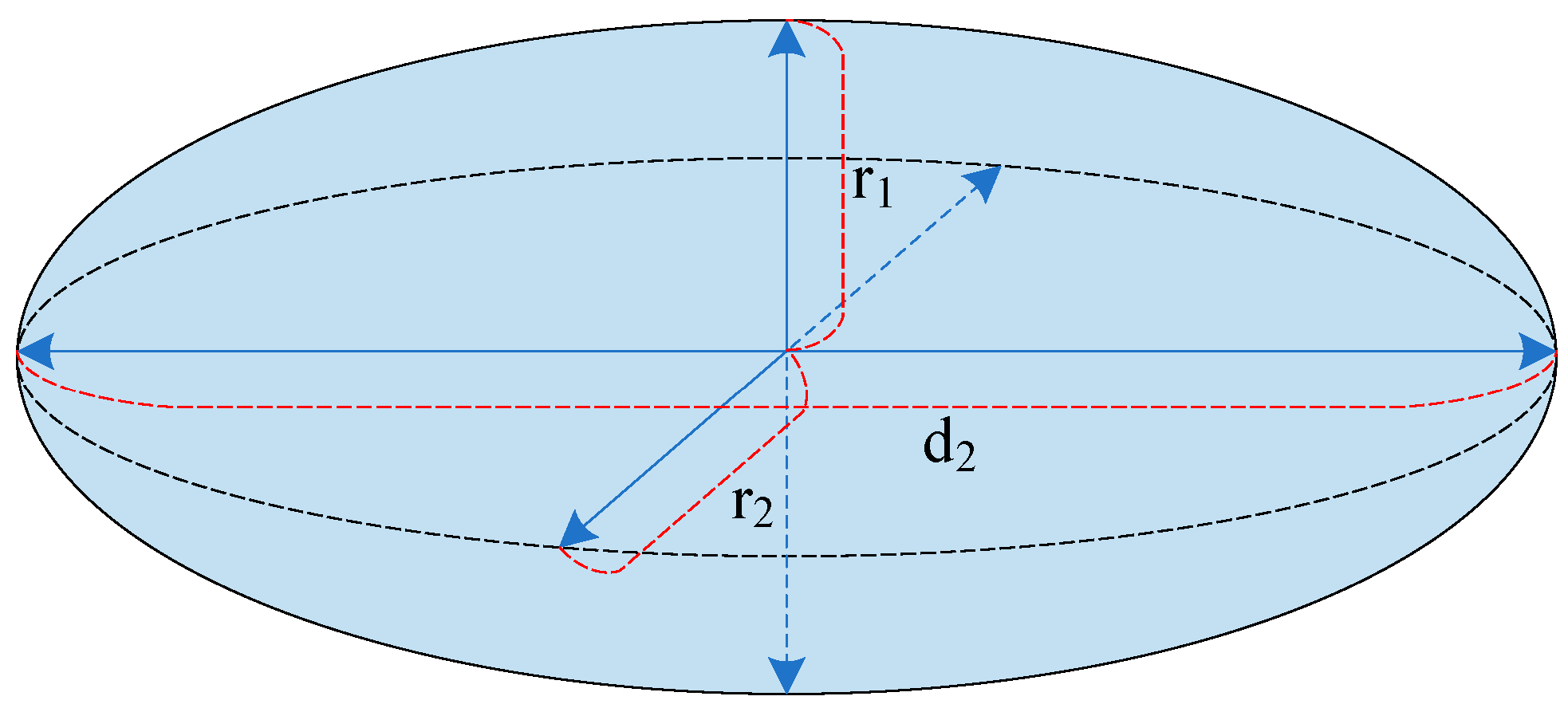
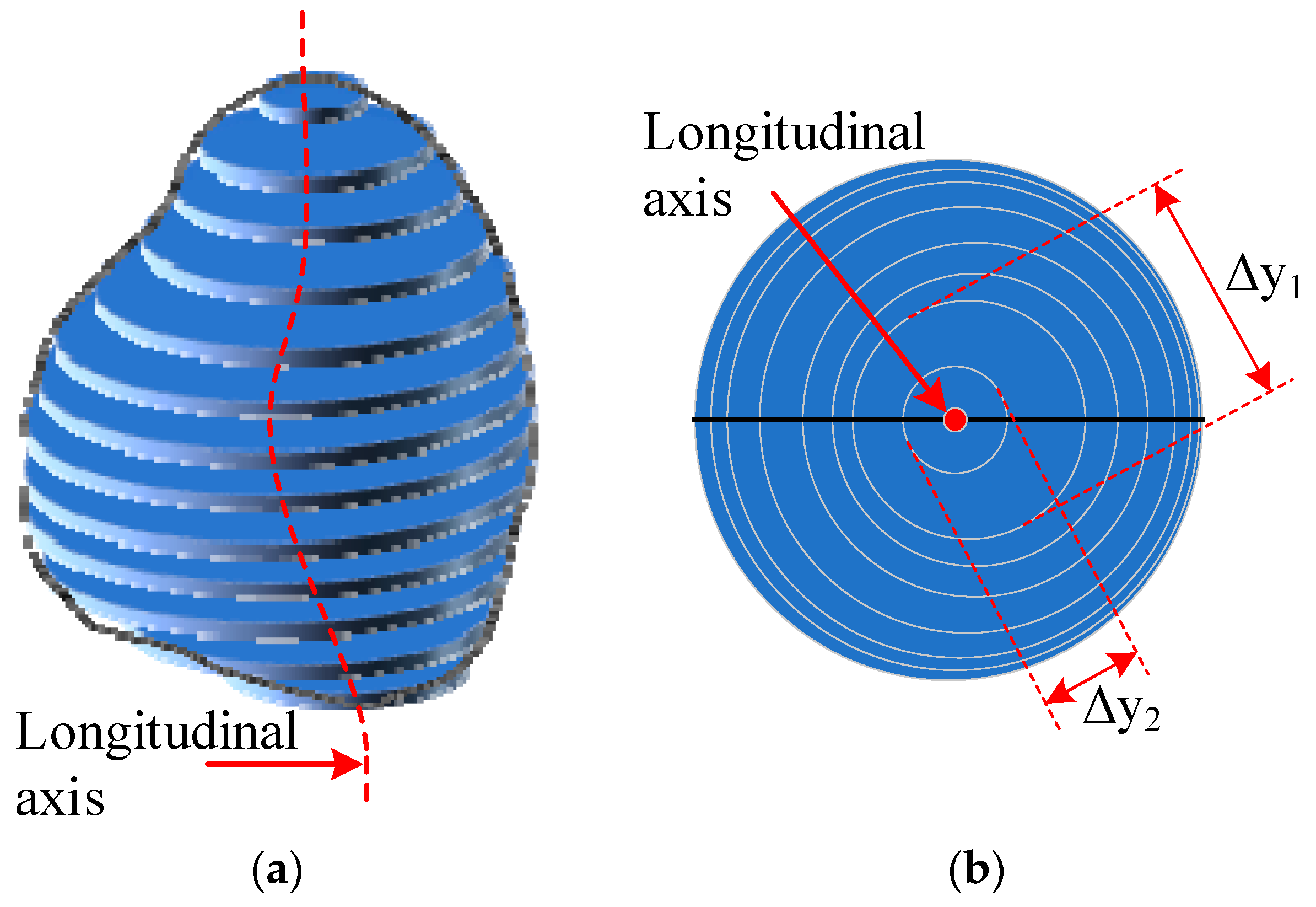

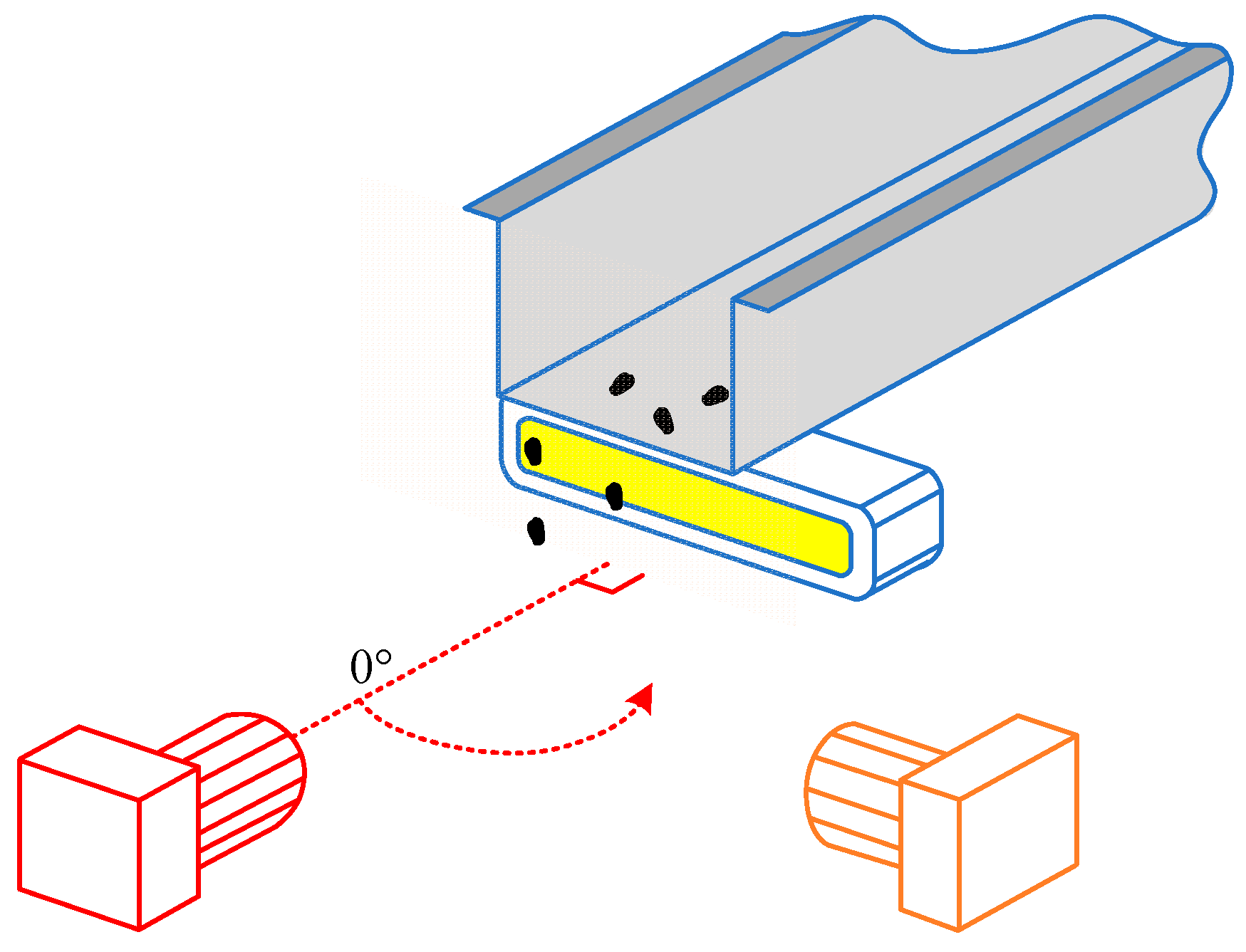

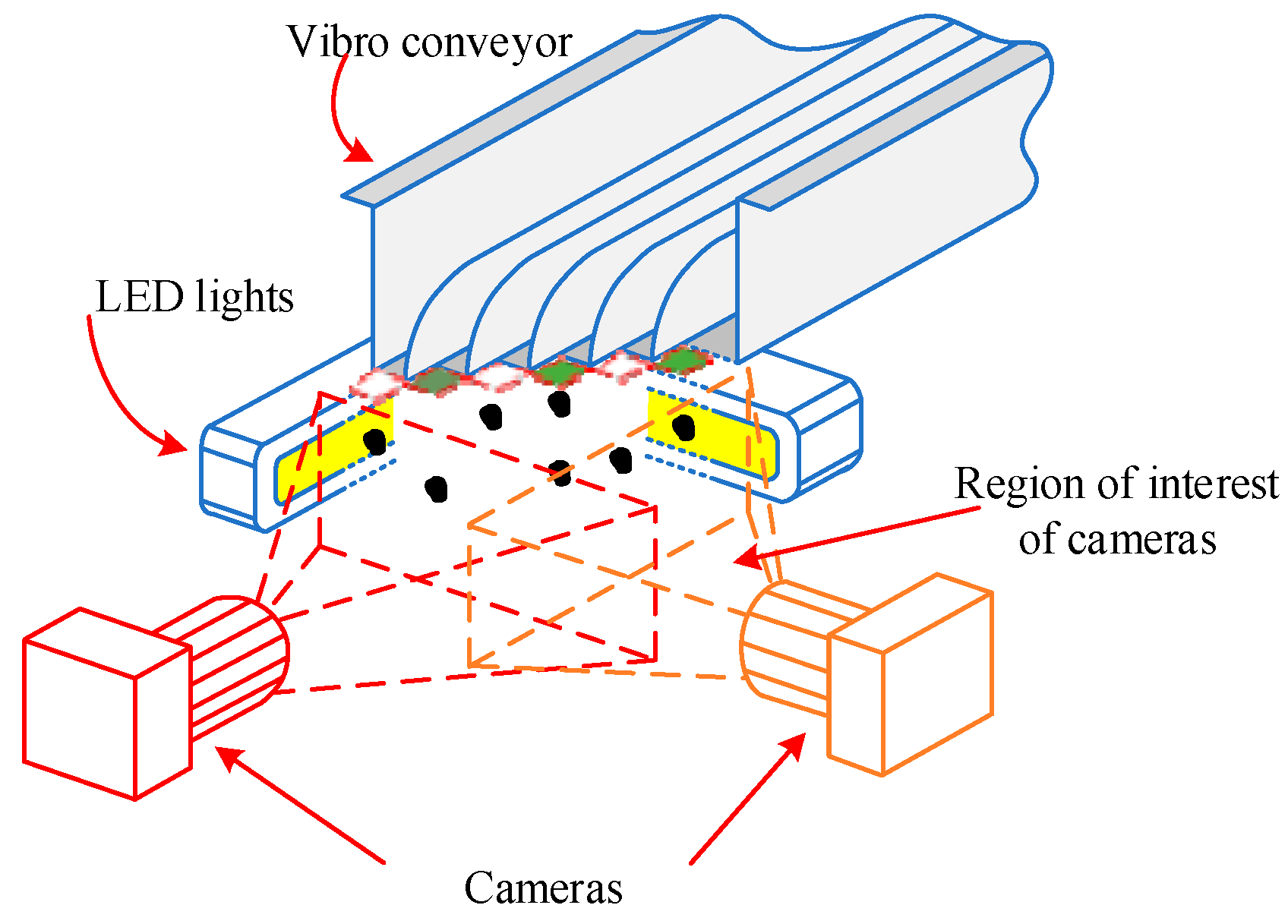
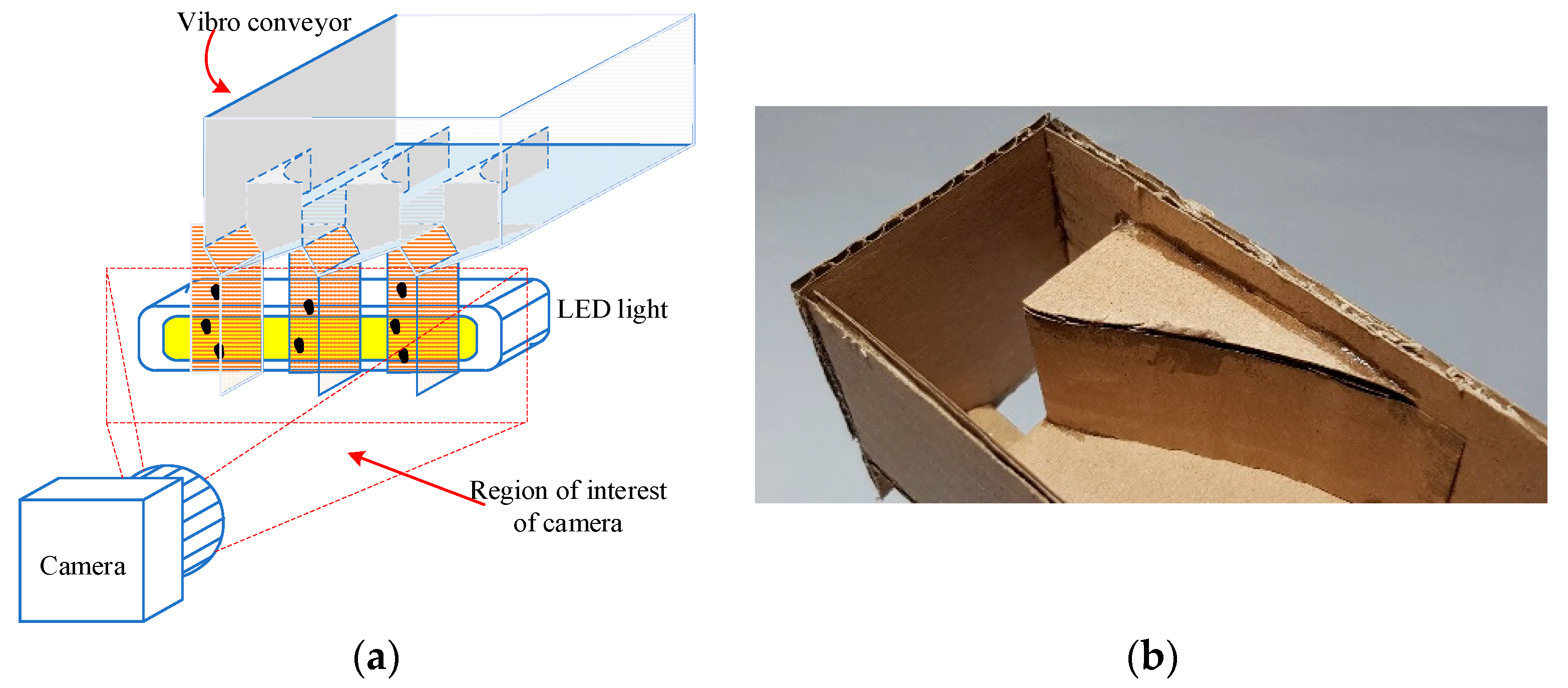


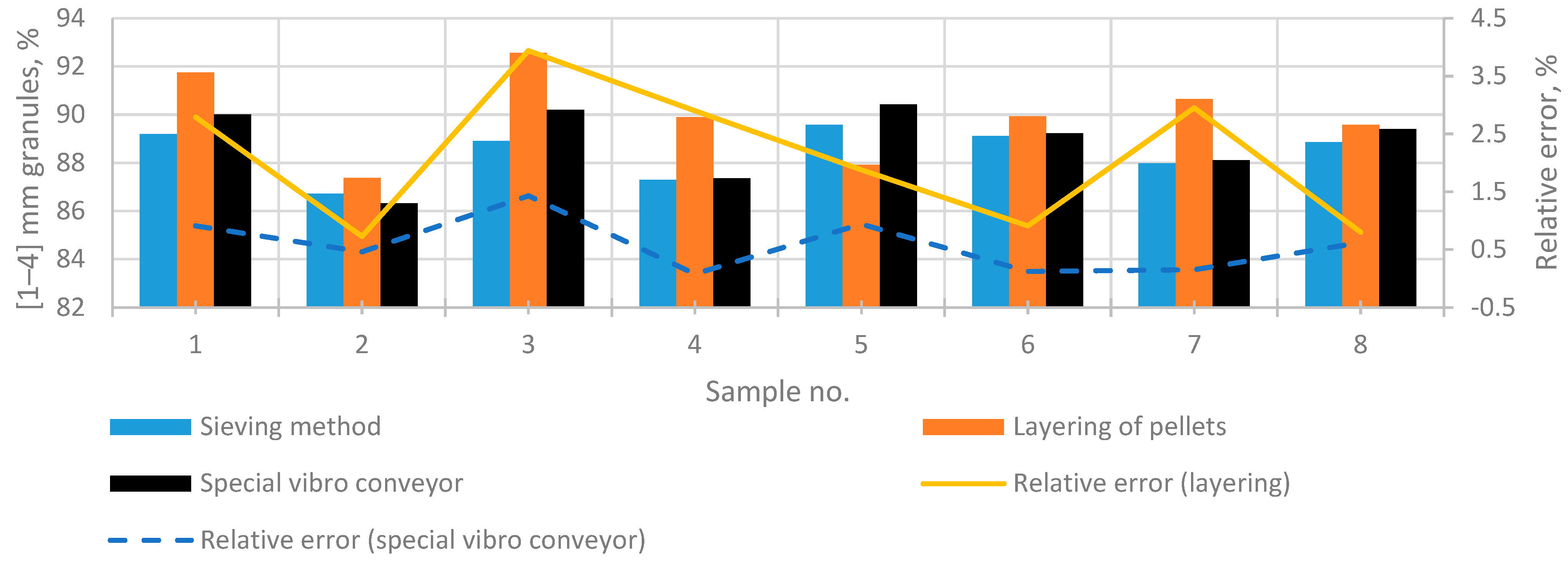

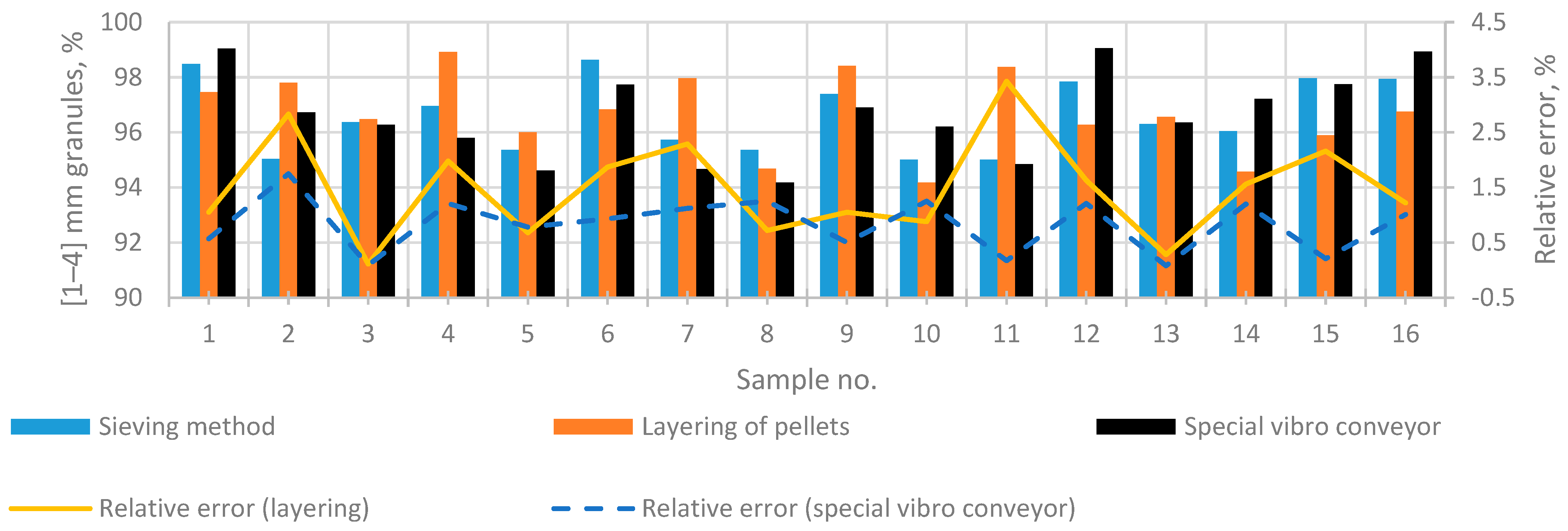
| Sample | Camera Positions | Average | Standard Deviation (SD) | The Volume of Granule Model V *, mL | |||||||
|---|---|---|---|---|---|---|---|---|---|---|---|
| 0° | 15° | 30° | 45° | 60° | 75° | ||||||
| 1 | Camera positions | 15° | 0.521 | 0.5 | |||||||
| 30° | 0.534 | 0.518 | 0.526 | 0.008 | |||||||
| 45° | 0.484 | 0.471 | 0.481 | 0.479 | 0.006 | ||||||
| 60° | 0.433 | 0.421 | 0.430 | 0.393 | 0.419 | 0.016 | |||||
| 75° | 0.440 | 0.424 | 0.437 | 0.396 | 0.358 | 0.411 | 0.031 | ||||
| 90° | 0.440 | 0.424 | 0.437 | 0.396 | 0.358 | 0.364 | 0.403 | 0.033 | |||
| Average | 0.475 | 0.452 | 0.446 | 0.395 | 0.358 | ||||||
| SD | 0.041 | 0.038 | 0.020 | 0.001 | 0.000 | ||||||
| 2 | Camera positions | 15° | 0.600 | 0.6 | |||||||
| 30° | 0.597 | 0.612 | 0.605 | 0.008 | |||||||
| 45° | 0.609 | 0.625 | 0.622 | 0.619 | 0.007 | ||||||
| 60° | 0.550 | 0.562 | 0.559 | 0.575 | 0.562 | 0.009 | |||||
| 75° | 0.556 | 0.569 | 0.565 | 0.581 | 0.531 | 0.560 | 0.017 | ||||
| 90° | 0.537 | 0.550 | 0.543 | 0.562 | 0.512 | 0.521 | 0.538 | 0.017 | |||
| Average | 0.575 | 0.584 | 0.572 | 0.573 | 0.522 | ||||||
| SD | 0.028 | 0.029 | 0.030 | 0.008 | 0.010 | ||||||
| 3 | Camera positions | 15° | 0.622 | 0.6 | |||||||
| 30° | 0.650 | 0.663 | 0.657 | 0.007 | |||||||
| 45° | 0.656 | 0.669 | 0.697 | 0.674 | 0.017 | ||||||
| 60° | 0.638 | 0.653 | 0.678 | 0.691 | 0.665 | 0.021 | |||||
| 75° | 0.578 | 0.590 | 0.616 | 0.628 | 0.612 | 0.605 | 0.018 | ||||
| 90° | 0.559 | 0.572 | 0.597 | 0.612 | 0.594 | 0.543 | 0.580 | 0.024 | |||
| Average | 0.617 | 0.629 | 0.647 | 0.644 | 0.603 | ||||||
| SD | 0.036 | 0.040 | 0.042 | 0.034 | 0.009 | ||||||
| 4 | Camera positions | 15° | 0.738 | 0.9 | |||||||
| 30° | 0.729 | 0.719 | 0.724 | 0.005 | |||||||
| 45° | 0.791 | 0.779 | 0.773 | 0.781 | 0.007 | ||||||
| 60° | 0.838 | 0.826 | 0.817 | 0.892 | 0.843 | 0.029 | |||||
| 75° | 0.860 | 0.848 | 0.838 | 0.914 | 0.970 | 0.886 | 0.050 | ||||
| 90° | 0.876 | 0.864 | 0.851 | 0.926 | 0.986 | 1.014 | 0.920 | 0.062 | |||
| Average | 0.805 | 0.807 | 0.820 | 0.911 | 0.978 | ||||||
| SD | 0.057 | 0.053 | 0.030 | 0.014 | 0.008 | ||||||
| 5 | Camera positions | 15° | 0.436 | 0.4 | |||||||
| 30° | 0.437 | 0.449 | 0.443 | 0.006 | |||||||
| 45° | 0.452 | 0.465 | 0.465 | 0.461 | 0.006 | ||||||
| 60° | 0.443 | 0.456 | 0.455 | 0.481 | 0.459 | 0.014 | |||||
| 75° | 0.430 | 0.443 | 0.443 | 0.465 | 0.459 | 0.448 | 0.013 | ||||
| 90° | 0.402 | 0.415 | 0.415 | 0.430 | 0.424 | 0.415 | 0.417 | 0.009 | |||
| Average | 0.433 | 0.446 | 0.445 | 0.459 | 0.442 | ||||||
| SD | 0.016 | 0.017 | 0.019 | 0.021 | 0.018 | ||||||
| Non-Contact Measurement Method | ||||||||
|---|---|---|---|---|---|---|---|---|
| Measurement no. | Sieving Method, % | Pellets Layering Method, % | Absolute Error, % | Relative Error σ1, % | Special Vibroconveyor, % | Absolute Error, % | Relative Error σ2, % | σ2–σ1, % |
| 1 | 93.92 | 90.94 | 2.98 | 3.28 | 92.47 | 1.45 | 1.57 | −1.71 |
| 2 | 98.48 | 97.46 | 1.02 | 1.05 | 99.04 | 0.56 | 0.57 | −0.48 |
| 3 | 92.96 | 94.6 | 1.64 | 1.73 | 94.56 | 1.60 | 1.69 | −0.04 |
| 4 | 94.98 | 98.09 | 3.11 | 3.17 | 96.26 | 1.28 | 1.33 | −1.84 |
| 5 | 95.04 | 97.81 | 2.77 | 2.83 | 96.73 | 1.69 | 1.75 | −1.08 |
| 6 | 96.37 | 96.48 | 0.11 | 0.11 | 96.28 | 0.09 | 0.09 | −0.02 |
| 7 | 96.96 | 98.92 | 1.96 | 1.98 | 95.8 | 1.16 | 1.21 | −0.77 |
| 8 | 95.36 | 96.01 | 0.65 | 0.68 | 94.62 | 0.74 | 0.78 | 0.11 |
| 9 | 98.64 | 96.83 | 1.81 | 1.87 | 97.73 | 0.91 | 0.93 | −0.94 |
| 10 | 92.6 | 89.98 | 2.62 | 2.91 | 91.3 | 1.30 | 1.42 | −1.49 |
| 11 | 95.73 | 97.97 | 2.24 | 2.29 | 94.67 | 1.06 | 1.12 | −1.17 |
| 12 | 89.19 | 91.75 | 2.56 | 2.79 | 90.01 | 0.82 | 0.91 | −1.88 |
| 13 | 86.73 | 87.37 | 0.64 | 0.73 | 86.33 | 0.40 | 0.46 | −0.27 |
| 14 | 92.43 | 92.09 | 0.34 | 0.37 | 91.72 | 0.71 | 0.77 | 0.40 |
| 15 | 95.36 | 94.68 | 0.68 | 0.72 | 94.18 | 1.18 | 1.25 | 0.53 |
| 16 | 97.39 | 98.42 | 1.03 | 1.05 | 96.91 | 0.48 | 0.50 | −0.55 |
| 17 | 91.4 | 93.07 | 1.67 | 1.79 | 91.05 | 0.35 | 0.38 | −1.41 |
| 18 | 88.91 | 92.56 | 3.65 | 3.94 | 90.2 | 1.29 | 1.43 | −2.51 |
| 19 | 87.29 | 89.9 | 2.61 | 2.90 | 87.36 | 0.07 | 0.08 | −2.82 |
| 20 | 89.57 | 87.92 | 1.65 | 1.88 | 90.42 | 0.85 | 0.94 | −0.94 |
| 21 | 95.01 | 94.18 | 0.83 | 0.88 | 96.21 | 1.20 | 1.25 | 0.37 |
| 22 | 92.08 | 94.57 | 2.49 | 2.63 | 92.57 | 0.49 | 0.53 | −2.10 |
| 23 | 95.01 | 98.38 | 3.37 | 3.43 | 94.85 | 0.16 | 0.17 | −3.26 |
| 24 | 91.52 | 88.43 | 3.09 | 3.49 | 90.18 | 1.34 | 1.49 | −2.01 |
| 25 | 97.85 | 96.28 | 1.57 | 1.63 | 99.05 | 1.20 | 1.21 | −0.42 |
| 26 | 93.02 | 92.67 | 0.35 | 0.38 | 93.46 | 0.44 | 0.47 | 0.09 |
| 27 | 91.78 | 89.71 | 2.07 | 2.31 | 92.55 | 0.77 | 0.83 | −1.48 |
| 28 | 89.11 | 89.93 | 0.82 | 0.91 | 89.22 | 0.11 | 0.12 | −0.79 |
| 29 | 91.7 | 91.14 | 0.56 | 0.61 | 91.64 | 0.06 | 0.07 | −0.55 |
| 30 | 87.98 | 90.65 | 2.67 | 2.95 | 88.11 | 0.13 | 0.15 | −2.80 |
| 31 | 93.36 | 92.3 | 1.06 | 1.15 | 93.74 | 0.38 | 0.41 | −0.74 |
| 32 | 96.3 | 96.57 | 0.27 | 0.28 | 96.38 | 0.08 | 0.08 | −0.20 |
| 33 | 92.35 | 94.21 | 1.86 | 1.97 | 93.71 | 1.36 | 1.45 | −0.52 |
| 34 | 96.05 | 94.57 | 1.48 | 1.56 | 97.22 | 1.17 | 1.20 | −0.36 |
| 35 | 91.29 | 92.28 | 0.99 | 1.07 | 92.82 | 1.53 | 1.65 | 0.58 |
| 36 | 90.42 | 89.69 | 0.73 | 0.81 | 89.54 | 0.88 | 0.98 | 0.17 |
| 37 | 94.72 | 92.32 | 2.4 | 2.60 | 93.43 | 1.29 | 1.38 | −1.22 |
| 38 | 93.27 | 92.39 | 0.88 | 0.95 | 93.53 | 0.26 | 0.28 | −0.67 |
| 39 | 93.47 | 93.05 | 0.42 | 0.45 | 94.11 | 0.64 | 0.68 | 0.23 |
| 40 | 88.85 | 89.57 | 0.72 | 0.80 | 89.4 | 0.55 | 0.62 | −0.19 |
| 41 | 93.87 | 94.89 | 1.02 | 1.07 | 93.59 | 0.28 | 0.30 | −0.78 |
| 42 | 94.57 | 92.46 | 2.11 | 2.28 | 93.94 | 0.63 | 0.67 | −1.61 |
| 43 | 97.96 | 95.89 | 2.07 | 2.16 | 97.75 | 0.21 | 0.21 | −1.94 |
| 44 | 91.01 | 87.13 | 3.88 | 4.45 | 89.6 | 1.41 | 1.57 | −2.88 |
| 45 | 90.47 | 89.28 | 1.19 | 1.33 | 91.75 | 1.28 | 1.40 | 0.06 |
| 46 | 94.37 | 92.06 | 2.31 | 2.51 | 93.35 | 1.02 | 1.09 | −1.42 |
| 47 | 91.7 | 89.64 | 2.06 | 2.30 | 91.52 | 0.18 | 0.20 | −2.10 |
| 48 | 97.94 | 96.76 | 1.18 | 1.22 | 98.94 | 1.00 | 1.01 | −0.21 |
| 49 | 94.94 | 92.39 | 2.55 | 2.76 | 94.08 | 0.86 | 0.91 | −1.85 |
| 50 | 91.51 | 90.21 | 1.3 | 1.44 | 91.82 | 0.31 | 0.34 | −1.10 |
Disclaimer/Publisher’s Note: The statements, opinions and data contained in all publications are solely those of the individual author(s) and contributor(s) and not of MDPI and/or the editor(s). MDPI and/or the editor(s) disclaim responsibility for any injury to people or property resulting from any ideas, methods, instructions or products referred to in the content. |
© 2023 by the authors. Licensee MDPI, Basel, Switzerland. This article is an open access article distributed under the terms and conditions of the Creative Commons Attribution (CC BY) license (https://creativecommons.org/licenses/by/4.0/).
Share and Cite
Laucka, A.; Andriukaitis, D.; Valinevicius, A.; Zilys, M.; Navikas, D.; Balasevicius, L.; Merfeldas, A.; Sotner, R.; Jerabek, J.; Li, Z.; et al. New Approach for Fertiliser Size Assessment Using Contactless Scanning. Mathematics 2023, 11, 3676. https://doi.org/10.3390/math11173676
Laucka A, Andriukaitis D, Valinevicius A, Zilys M, Navikas D, Balasevicius L, Merfeldas A, Sotner R, Jerabek J, Li Z, et al. New Approach for Fertiliser Size Assessment Using Contactless Scanning. Mathematics. 2023; 11(17):3676. https://doi.org/10.3390/math11173676
Chicago/Turabian StyleLaucka, Andrius, Darius Andriukaitis, Algimantas Valinevicius, Mindaugas Zilys, Dangirutis Navikas, Leonas Balasevicius, Audrius Merfeldas, Roman Sotner, Jan Jerabek, Zhixiong Li, and et al. 2023. "New Approach for Fertiliser Size Assessment Using Contactless Scanning" Mathematics 11, no. 17: 3676. https://doi.org/10.3390/math11173676
APA StyleLaucka, A., Andriukaitis, D., Valinevicius, A., Zilys, M., Navikas, D., Balasevicius, L., Merfeldas, A., Sotner, R., Jerabek, J., Li, Z., & Ritonja, J. (2023). New Approach for Fertiliser Size Assessment Using Contactless Scanning. Mathematics, 11(17), 3676. https://doi.org/10.3390/math11173676








